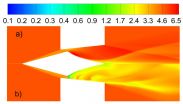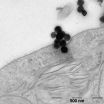(Press-News.org) Many factors, both genetic and environmental, have been blamed for increasing the risk of a diagnosis of schizophrenia. Some, such as a family history of schizophrenia, are widely accepted. Others, such as infection with Toxoplasma gondii, a parasite transmitted by soil, undercooked meat and cat feces, are still viewed with skepticism.
A new study by Gary Smith, professor of population biology and epidemiology at the University of Pennsylvania's School of Veterinary Medicine, used epidemiological modeling methods to determine the proportion of schizophrenia cases that may be attributable to T. gondii infection. The work, published in the journal Preventive Veterinary Medicine, suggests that about one-fifth of cases may involve the parasite.
"Infection with Toxoplasma is very common, so, even if only a small percentage of people suffer adverse consequences, we could be talking about problems that affect thousands and thousands of people," Smith said.
In the United States, just over a fifth of the population is infected with T. gondii. The vast majority aren't aware of it. But there are some populations that need to be concerned. For example, if a woman becomes infected for the first time during pregnancy, her fetus can die or suffer serious developmental problems. People with HIV or other diseases that weaken the immune system are susceptible to a complication of T. gondii infection called toxoplasmic encephalitis, which can be deadly.
Though the medical community has long believed that most healthy people suffer no adverse effects from a T. gondii infection, recent studies have found evidence of worrisome impacts, including an association with schizophrenia because the parasite is found in in the brain as well as in muscles. Other work has shown that some antipsychotic drugs can stop the parasite from reproducing. In addition, field and laboratory studies in mice, rats and people have shown that infection with T. gondii triggers changes in behavior and personality.
To further investigate this connection, Smith sought to calculate the population attributable fraction, or PAF, a metric epidemiologists use to determine how important a risk factor might be. In this case, Smith explained that the PAF is "the proportion of schizophrenia diagnoses that would not occur in a population if T. gondii infections were not present."
The usual method of calculating the PAF was not well suited to examining the link between schizophrenia and T. gondii, because some of the variables are constantly in flux. For example, the proportion of people infected by T. gondii increases with age. Using a standard epidemiological modeling format, but taking into account all of the age-related changes in the relevant factors, Smith found the average PAF during an average lifetime to be 21.4 percent.
"In other words, we ask, if you could stop infections with this parasite, how many cases could you prevent?" Smith said. "Over a lifetime, we found that you could prevent one-fifth of all cases. That, to me, is significant."
Smith noted that in some countries, the prevalence of T. gondii infection is much higher than in the U.S., and these countries also have a higher incidence of schizophrenia.
People with schizophrenia have greatly reduced life expectancies, and many are unable to work. Family members may also leave the workforce to care for relatives with the disease. For these reasons and others, schizophrenia acts as a large drain on the economy, responsible for $50 to $60 billion in health-care expenditures in the U.S. each year.
"By finding out how important a factor T. gondii infection is, this work might inform our attitude to researching the subject," Smith said. "Instead of ridiculing the idea of a connection between T. gondii and schizophrenia because it seems so extraordinary, we can sit down and consider the evidence. Perhaps then we might be persuaded to look for more ways to reduce the number of people infected with Toxoplasma."
INFORMATION:
The study was supported by the University of Pennsylvania School of Veterinary Medicine.
Penn vet professor investigates parasite-schizophrenia connection
2014-10-29
ELSE PRESS RELEASES FROM THIS DATE:
Clean smell doesn't always mean clean air
2014-10-29
Some of the same chemical reactions that occur in the atmosphere as a result of smog and ozone are actually taking place in your house while you are cleaning. A researcher in Drexel's College of Engineering is taking a closer look at these reactions, which involve an organic compound -called limonene- that provides the pleasant smell of cleaning products and air fresheners. His research will help to determine what byproducts these sweet-smelling compounds are adding to the air while we are using them to remove germs and odors.
Secondary organic aerosols (SOAs) are microscopic ...
NIST 'combs' the atmosphere to measure greenhouse gases
2014-10-29
By remotely "combing" the atmosphere with a custom laser-based instrument, researchers from the National Institute of Standards and Technology (NIST), in collaboration with researchers from the National Oceanic and Atmospheric Administration (NOAA), have developed a new technique that can accurately measure—over a sizeable distance—amounts of several of the major "greenhouse" gases implicated in climate change.
The technique potentially could be used in several ways to support research on atmospheric greenhouse gases. It can provide accurate data to support ...
Liberal or conservative? Reactions to disgust are a dead giveaway
2014-10-29
The way a person's brain responds to a single disgusting image is enough to reliably predict whether he or she identifies politically as liberal or conservative. As we approach Election Day, the researchers say that the findings reported in the Cell Press journal Current Biology on October 30 come as a reminder of something we all know but probably don't always do: "Think, don't just react."
P. Read Montague of Virginia Tech says he was initially inspired by evidence showing that an individual's political affiliation is almost as heritable as height. Montague and his ...
New technology on the way to aid cancer suffers who lose their hair after chemotherapy
2014-10-29
Cancer suffers who lose their hair as a consequence of chemotherapy will benefit from a major research project that will improve the scalp cooling technology that prevents hair loss.
The research is being now underway and is being pioneered by global scalp cooling manufacturing company, Paxman Coolers, of Fenay Bridge, Huddersfield, in conjunction with the biology department of the University of Huddersfield.
The research will be led by key researcher Omar Hussain, who has a background in the pharmacology of cancer treatment, which he will use towards his PhD.
Omar ...
EEG test to help understand and treat schizophrenia
2014-10-29
Researchers at University of California, San Diego School of Medicine have validated an EEG test to study and treat schizophrenia. The findings, published in two separate studies, offer a clinical test that could be used to help diagnose persons at risk for developing mental illness later in life, as well as an approach for measuring the efficacies of different treatment options.
One of the studies, reported online Oct. 23 in Schizophrenia Research, shows that schizophrenia patients don't register subtle changes in reoccurring sounds as well as others and that this deficit ...
Decades of research: Effectiveness of phone counseling for cancer patients still unknown
2014-10-29
Increasingly, cancer care respects the fact that a patient's body is only part of the system that requires treatment. Over a third of cancer patients experience psychosocial distress – the mental health consequences of their conditions. And, increasingly, care providers are exploring phone- and internet-based interventions to help cancer patients navigate mental health challenges. A University of Colorado Cancer Center study recently published in the journal Psycho-Oncology asks an important question: after decades of use and study, can we definitely show that remote ...
Supersonic laser-propelled rockets
2014-10-29
WASHINGTON, Oct. 29, 2014—Scientists and science fiction writers alike have dreamt of aircrafts that are propelled by beams of light rather than conventional fuels. Now, a new method for improving the thrust generated by such laser-propulsion systems may bring them one step closer to practical use.
The method, developed by physicists Yuri Rezunkov of the Institute of Optoelectronic Instrument Engineering, Russia and Alexander Schmidt of the Ioffe Physical Technical Institute in Saint Petersburg, Russia is described today in The Optical Society's (OSA) journal Applied ...
Can plants edge out petroleum as raw material for textiles and plastics?
2014-10-29
Your next pair of spandex pants could be made out of corn — or, more precisely, from dextrose derived from corn. This option is part of a new wave, albeit a small one, of consumer goods that are being produced from plants rather than petroleum-based materials. But a complete transition to a biobased economy won't be easy, according to an article in Chemical & Engineering News (C&EN), the weekly newsmagazine of the American Chemical Society.
Melody M. Bomgardner, a senior editor at C&EN, notes that a range of companies, from start-up firms to industrial giants, have ...
Nanosafety research: The quest for the gold standard
2014-10-29
Researching the safety of nanoparticles is all the rage. Thousands of scientists worldwide are conducting research on the topic, examining the question of whether titanium dioxide nanoparticles from sun creams can get through the skin and into the body, whether carbon nanotubes from electronic products are as hazardous for the lungs as asbestos used to be or whether nanoparticles in food can get into the blood via the intestinal flora, for instance. Public interest is great, research funds are flowing – and the number of scientific projects is skyrocketing: between ...
Free urban data -- what's it good for?
2014-10-29
New Rochelle, October 29, 2014 –Cities around the world are increasingly making urban data freely available to the public. But is the content or structure of these vast data sets easy to access and of value? A new study of more than 9,000 data sets from 20 cities presents encouraging results on the quality and volume of the available data and describes the challenges and benefits of analyzing and integrating these expanding data sets, as described in an article in Big Data, the highly innovative, peer-reviewed journal from Mary Ann Liebert, Inc., publishers. The Open ...





